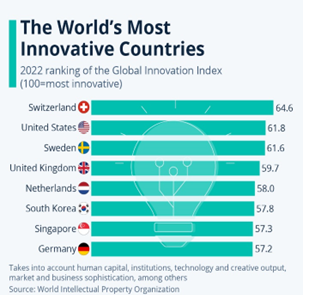Hi readers!
On March 30th, 2024, “Nature news” published an article on increase in Chinese research funding to the tune of 371 billion yuan (app. US$ 52 billion) which is equal to 10 % increase in the previous allocation.
The announcement came in the middle of the ongoing annual session of the National People’s Congress, with the legislative body reviewing the draft budget report submitted by the Ministry of Finance. The commitment to allocate substantial resources to science and technology therefore, reflected the government’s recognition of the fundamental role played by innovations in driving economic growth and developing/nurturing national capability to withstand or recover quickly from difficulties.
Of the total government spending on science and technology, a significant portion of the funding amounting to 98 billion yuan is earmarked for basic research and an increase of 13% from the previous year. This infusion of funds into foundational research endeavors emphasizes China’s determination to strengthen her scientific capabilities and enhance her global competitiveness in emerging technologies.
China’s move of increasing funding is being considered as a strategic shift towards high tech development for fulfilling her ambitions (provoked through restrictions imposed on her) to become the world technological leader. The increase will specifically enhance capabilities in artificial intelligence and semiconductors. It has double edge significance as firstly the increase in funding signifies Chinese dedication to science and technology, and secondly it is indicative of her strategic shift towards high-tech development which is a shrewd move towards fundamental transition in her economy.
Now let’s look into the background this transition through data presented in the following four figures which is about the innovative countries.
Innovation is a process of turning new ideas into value in the form of products, services, business models, and other new ways of doing things. It is complex and goes beyond mere creativity and invention to include the practical steps necessary for facilitating adoption. More innovative countries have a competitive and diversified economy that fosters entrepreneurship. They invest in research and development (R&D), infrastructure, and education to create skilled and knowledgeable workforce to generate new ideas and technologies.


It is clear in the above figure (which is about innovation index of 2021), that Switzerland, Sweden, US, UK, South Korea, Netherlands, Finland and Singapore were among the most innovative countries while in figure 2 (which is about data related with 2022) Sweden’s position is changed, Finland is removed, and Germany has entered the list. In figure 3 below (which is about data related with 2023, Finland re-entered the list while South Korea is removed. This means that Switzerland, Sweden, US, UK, South Korea, Netherlands, Finland, Singapore and Germany are always considered the most innovative countries with their positions fluctuating with respect to the countries in the list.


Source data: Statista: a German online platform that specializes in data gathering and visualization.
Figure 4 below however, indicates anticipated distribution of economic growth in the world between the period of 2023 and 2028. Unlike the most innovative countries, China appeared at the top while Indonesia, Türkiye, Japan, Brazil, Egypt, Russia, Bangladesh, Vietnam and France has entered the list and UK got the last but one position and Singapore has been removed. This means that irrespective of most of the innovative countries China which is not yet being considered an innovative country is contributing the maximum (22.6% which is exceptionally high) in the world economic growth 5 years down the line.
The boost in China’s research funding was announced in March 2023, and is indicative of her improved dedication to science and technology but analyst believes that this increase in funding constitutes a relatively restrained fraction of China’s overall research and development expenditure amounting to merely 11% of the total 3.3 trillion yuan allocated to R&D which means that those who calculated the contribution of China into world’s economy up to 2028 are not considering the increased funding only but her overall scientific budget.
The increase in funding is supposed to be for enhancing research on Artificial intelligence and semiconductor research.
China’s semiconductor industry is on the fast track of development as witnessed by China’s total output of integrated circuits (IC’s) which is also known as a microchip (a small electronic device made up of multiple interconnected electronic components such as transistors, resistors, and capacitors imprinted onto a small piece of semiconductor material, usually silicon) which in 2023, increased by 6.9% and reached to 351.4 billion pieces in 2024 as indicated by data from the Chinese Ministry of Industry and Information Technology.
In 2022, China’s semiconductor industry had a combined market value of 1.26 trillion yuan: the largest segment of which is chip design, that contributed a total value of 586 billion yuan. China can (if wishes so) double the allocation for chip design from 586 billion yuan to one trillion yuan, imagine her market value in the year ahead.
Although, the long-term capability of China’s chip industry cannot be comprehended but the chances of her developing advanced chip-making capabilities is almost certain. Demand for chips is projected to drive a trillion-dollar industry by 2030, and China now leads the world in terms of the number of new fabs under construction. There are currently 73 new semiconductor fabs being built around the world, which includes those that are completely new fabrication sites and those that are expansions on existing sites and China is leading in those that are completely new fabrication. No wonder, why China (despite being absent in list of innovative countries) will contribute the maximum to the world economy in the year 2028?
Patric Gelsinger’s (American business executive and engineer) estimates reported recently (19-Jan-2024) indicated that China’s semiconductor industry lags behind the global standard by about ten years and, although it will continue to develop, he foresees this gap persisting for the next decade. The reason could be that Chinese technology has remained behind the world’s frontier who has approached 3-nanometre chips whereas Huawei’s homemade chip is at 7 nanometers.
Maintaining this distance is perhaps important for economic and security reasons. Since semiconductor manufacturing relies on intricate global supply chains and Chinese companies depend on a network of suppliers for critical materials, equipment, and components hence, any disruption in this supply chain can have significant consequences for semiconductor industry. Huawei’s 7 nanometer chip is like playing safe as it is homemade and is therefore disruption free. But China is slowly getting close to the world frontiers by increasing her research funding through which she will equip the laboratories, upgrade infrastructure and provide facilities to the scientists conducive for the research.
China is perhaps the only country where scientists work hand in hands with her Peoples Liberation Army (PLA) it is, therefore, hoped that the gap between 7 and 3 nanometer will be bridged in less than 5 years against the hope of Patric Geisinger for 10 years or more (already reflected in figure 4).
Did you see dear readers, how nations progress. They think rationally, decide quickly and implement decision even more quickly unlike the dear Pakistani who remain “indecisive” in most of her endeavors and keep loosing every opportunity that comes into their way.
May Allah Almighty save us from such idleness.
That’s all for now. See you next week. Take care, Bye.




